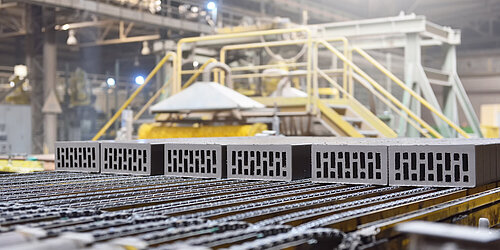Ceramics emits significant quantities of greenhouse gases
From household tableware to building materials (bricks, roofing, bathroom or floor tiles and sanitary ware) ceramic products are an indispensable part of our day-to-day lives. Ceramics are also used in modern medical and automotive systems. These ‘technical’ ceramics can be used as a bone substitute or as an insulator for spark plugs in cars. Fireproof ceramics also form the linings of the kilns used in high-temperature industrial processes.
Tile production causes particularly high greenhouse gas emissions
Ceramic products are generally very durable. However, the production of ceramics currently emits significant quantities of greenhouse gases. These are due to the necessary firing process with temperatures from over 700 °C to over 2,000 °C, depending on the product. The ceramics industry is therefore one of the energy-intensive industries subject to emissions trading.
Despite comparatively low firing temperatures, tile making is the segment with the highest CO2 emissions in the ceramics industry. This is due to the segment’s sizeable output and a fairly substantial proportion of process-related emissions. Over the last few years, greenhouse gas emissions from the German tile making industry amounted to around 1.6 million t of CO2 per year. This accounts for roughly half of the greenhouse gas emissions for the entire ceramics industry.
Origins of process-related emissions
The process-related greenhouse gas emissions in the ceramics industry result on the one hand from naturally-occurring calcium carbonate (lime, CaCO3) and the organic impurities in the clays used. On the other hand, CO2 is also emitted during the burning of added porosity agents, which are used, for example, as pore-forming agents in thermal insulation bricks. While a transition to renewable raw materials is now underway in the case of porosification agents, the emissions from clay as a natural raw material are unavoidable.
New paths to a greenhouse gas-neutral tile industry
Over the last 30 years, the emissions savings in the industry are mainly due to process optimisation and associated energy efficiency measures. However, continuing along this same path is enough to achieve climate neutrality by 2045. Further paths to decarbonisation must be followed. The state of the art in tile production is a kiln-dryer system. These are tunnel kilns, where parts of the hot air from the kiln are fed into the dryer to dry the tiles. Future plans for greenhouse gas-neutral production involve breaking up this kiln-dryer combination to reduce energy demands. Instead, the tiles will be dried using an electrically powered process, while the kiln will be operated using a non-fossil fuel.
Challenges for climate-friendly processes in the ceramics industry
Challenges for the ceramics industry lie primarily in the conversion of the energy supply from fossil fuels to renewable alternatives. Targeted promotion of the use of electricity over hydrogen is necessary to stimulate the attractiveness and cost-effectiveness of this energy carrier. Political and economic measures will be necessary for the industrial ceramics industry (e.g. roofing tiles, bricks, fireproof ceramics) to implement strategies to successfully reduce its CO2 emissions. One particular issue here is the avoidance of ‘carbon leakage effects’. The term refers to a practice whereby energy-intensive industry segments move to countries that either have lower environmental standards or offer better conditions for ceramics production.
Contact
Linda Gümbel
Ceramics industry, glass industry
0355 47889-107
Write E-Mail
